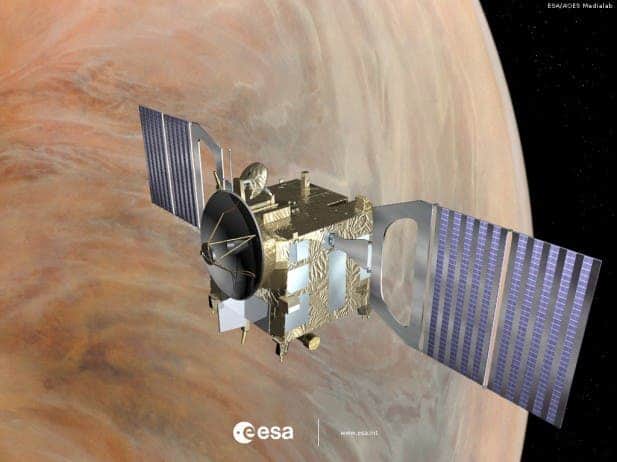
Venus Express has two solar cell panels per wing comprising alternating rows of standard triple junction solar cells as well as highly reflective mirrors to reduce the operating temperatures. (c) ESA
ESA’s Venus Express spacecraft has found an ozone layer high in the atmosphere of Venus, similar to that surrounding Earth and Mars according to astronomers. Ozone is considered fundumental to providing an environment capable of supporting life, as it absorbs much of the sun’s harmful ultraviolet ray. This recent discovery will provide highly valuable insight as to how life formed on our planet, as well as more refined parameters for scientists’ hunt for extraterestial life.
The study was recently presented at the Joint Meeting of the European Planetary Science Congress and the American Astronomical Society’s Division for Planetary Sciences. Franck Montmessin from the Laboratoire Atmospheres, Milieux, Observations Spatiales (LATMOS) in Guyancourt, France, led the team who carried out this study.
“This detection gives us an important constraint on understanding the chemistry of Venus’ atmosphere,” Franck Montmessin, who led the research, said in a press release.
The find was made with the help of SPICAV, an instrument aboard Venus Express, which analyzed the starlight around the planet and found characteristic fingerprints of gases in the atmosphere as they absorbed light. Ozone was detectable because it absorbed some of the ultraviolet from the starlight
Previous to this discovery, ozone has been observed on Earth and Mars only. The build-up of oxygen, and consequently ozone, in Earth’s atmosphere began 2.4 billion years ago. Scientists believe the ozone formed as a result of ancient microbes excreting oxygen as a waste gas, along with primitive plant life, which to this day are the main source of replenishing ozone. Greenhouse emissions gathered in the atmosphere in more than 100 years has taken its significant toll on Earth’s ozone along the years. It wouldn’t be too hard for Earth to become a second Venus in the future.
Venus’ ozone layer sits at an altitude of about 62 miles, which is about four times higher in the atmosphere than Earth’s. ESA said astrobiologists believe that a planet’s ozone concentration must be 20 percent of Earth’s value before life should be considered as a cause of it. Common sense would dictate that on a planet where acid rains and furnace hot surface temperatures dictate, any talk of signs of life would sound trivial, but bacteria and other sorts of micro organisms can find their niche even in the harshest of environments – even on a hellish planet like Venus.
“We can use these new observations to test and refine the scenarios for the detection of life on other worlds,” says Franck Montmessin, who led the research.









